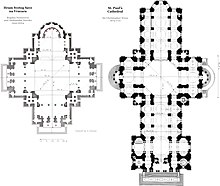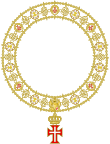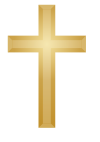User:Psycho CSL/基督教十字架變體




此為基督教十字架變體的列表。基督教的十字架是基督教主要的宗教象徵。帶有基督形象的十字架稱為十架苦像,而此形象通常被稱作「corpus(拉丁語中的身體)」。
希臘式十字架是一種四臂相等的十字架,而拉丁式十字架則是指上短下長的等臂十字架,在中世紀時期發展出許多其他的變體。
基督教十字架廣泛用於教堂、教會建築、聖經、紋章、私人的珠寶等地方,作為基督教的象徵。十字架也是基督教墓地的主要特徵,雕刻在墓碑上或將石碑雕刻成十字。有時在某些基督教文化的國家會使用小十字來標記命案事故的地點,或用來標記如楚格峰或皇家山等地,使其在整個周邊地區都能被清楚地看到。天主教、聖公會和路德教會的十字架通常是十架苦像,強調耶穌的重要性超過單獨的十字架。是路德教會的主要使用大型的十架苦像(如rood),而某些新教團體使用的是沒有主體(耶穌的身體)的十字架,將此形式的十字架解釋為復活的信念,而非耶穌死亡與復活之間的間隔。
電腦中的可見文本有幾種基督教十字架的變體。ASCII字符集的擴充版本包含了「拉丁十字 (†) 」,[1]Unicode1.1版本中也新增了幾種變體。[2]
變體列表[编辑]
基本形式[编辑]
以下為一些基本的和一些早期廣泛使用的變體。
| 圖像 | 名稱 | 外觀描述 |
|---|---|---|

|
希臘式十字架 | 四臂等長的十字,常見基督教十字架的形式之一,於4世紀廣泛使用。 |

|
拉丁式十字架 | 由長短兩條梁組成的十字架 ,是基督教最常見的十字架形式,代表耶穌受難時的十字架。 |

|
拜占庭式十字架 | 由兩條向外擴張的垂直線組成。常見於古典時代晚期 和中世紀前期拜占庭帝國的文物,並被當時的幾個基督教文化族群,如法蘭克人 和哥特人所使用。 |

|
宗主教十字 | 也稱為大主教十字或雙十字(crux gemina),由兩橫桿和一直桿互相垂直組成,上方的橫桿較短,代表釘在耶穌十字架上的牌匾。與洛林十字相似,但後者版本中下方的橫桿位置較低。 俄羅斯式十字架的版本則是在直桿下方加上一斜線。 |

|
雙交叉十字 | 八點交叉石儀式的雙十字符號(the eight-point cross-stone ceremony)。[需要解释] 其與希臘字母"XI"("基督"一詞的首字母 )相似,是代表復興的符號。[3] |

|
洛林十字 (two-barred cross) | 由一直桿和兩橫桿組成,直桿垂直並與兩橫桿交叉。位於上方的橫桿在多數版本中較下方橫桿短,但也有兩橫桿等長的版本。 |

|
教皇十字架 | 直桿上方有三橫桿的十字架,按照長短排列,最短的橫桿位於最上方。 |

|
耶穌聖心 | 以耶穌的心露於外,繞以茨冠,上有火焰和一個拉丁式十字架。 |

|
塞勒姆十字架 | 也被稱為教宗十字架( pontifical cross)與宗主教十字類似,差別在於前者下方多了一橫桿,與最上方橫桿等長。 |

|
花押十字/ Tau-Rho十字 | 早期的十字架圖像,出現在新約 手稿中的第66頁、第45頁及第75頁。[4] |

|
凱樂符號/基督符(Chrismon)/拉布蘭旗 | 凱樂符號(Chi Rho /ˈkaɪ ˈroʊ/)也稱作基督符(chrismon) ,是最早的基督圖像形式之一,由希臘單詞ΧΡΙΣΤΟΣ (Christos) 的前兩個(大寫)字母 chi 和 rho (ΧΡ) 疊加而成,其中 rho 的垂直筆劃與中心相交。 |

|
階梯式十字 | 一種立於階梯上的十字架(通常立於三級階梯上),也稱為卡瓦里十字 該符號首次出現在拜占庭皇帝 希拉克略(610–641 年在位)時期的鑄幣上。三個階梯分別代表 信、望、愛, 有時標記為 Fides(上)、Spes(中)和 Caritas(下),等詞的拉丁形式。[5] |
 
|
耶路撒冷十字 | 也被稱為十字軍的十字架,為一個大十字和四個小十字。被用來當作耶路撒冷王國的象徵。 |

|
環十字 | 外部有個圓環的十字架。這種十字架有許多變體,包含帶有光環的十字以及凱爾特十字。[6] 光環主要用於標示耶穌等代表三位一體的人物,常出現在中世紀的藝術作品中。 |

|
叉子十字 | 13世紀末與14世紀初流行於德國萊茵蘭的一種Y型十字,又名 crucifixus dolorosus。有時也被稱為叉子(furca)、Y型十架(ypsilon cross或Y-cross)、強盜十架(robber's cross)或竊賊十架(thief's cross)。 |
聖十字[编辑]
| 圖像 | 名稱 | 外觀描述 |
|---|---|---|

|
聖彼得十字架 | 一個倒置的十字架,代表聖彼得是被倒著釘死在十字架上的。 |
 
|
T型十字架 | 一個T型的十字架,也稱為聖安東尼十字架或聖方濟各十字架或承諾交叉(crux commissa)。 |

|
聖安德烈十字(crux decussata) | 呈X形的十字符號,相傳蘇格蘭的主保聖人安得烈殉道時被釘在X形十字架上,故這種十字也是蘇格蘭國旗上的符號。 |
 
|
聖布麗姬十字 | 與聖布麗姬相關的十字,也稱為基爾代爾十字,一般由燈芯草、麥稈之類的材料編織而成。在不同的狀況下可能是代表基督徒或異教徒的符號。 |

|
聖喬治十字 | 與經常被描繪成中世紀晚期的十字軍戰士的軍事聖人聖喬治相關,常出現在許多旗幟及紋章上。最早被用來當作熱那亞共和國軍旗的標誌,後來也被用於十字軍東征。而英格蘭國旗 及格魯吉亞國旗也用了這個符號。 |

|
水手十字架 | 也被稱為聖克萊孟十字,用於紀念聖克萊孟的殉道方式。 |

|
卡斯伯特胸十字 | 也被稱作索爾十字架。[來源請求] |

|
聖基路伯十字
(Portate cross) |
一種傾斜的十字架,看起來就像是被扛在肩上,沿著地面將其拖到受難地點一樣。 |

|
雅各 (亞勒腓的兒子)十字 | 紅色的十字,是十二世紀加利西亞和卡斯蒂利亞聖地亞哥軍事勳章的徽章,以聖雅各伯名字命名。 |

|
聖朱利安十字 | 傾斜45度,四個小十字頂部指向「世界的四個角落」的十字架。其有時被稱為傳教士十字架,原因與基督教的形象傳播到世界各地有關。 |

|
葡萄藤十字(聖尼諾十字架) | 也被稱為卡帕多西亞的聖尼諾十字架,聖尼諾使喬治亞基督教化。 |

|
聖多瑪十架 | 印度喀拉拉邦的聖多馬基督徒(或稱敘利亞基督徒或納斯拉尼)所使用的古老十字架。[7] |

|
斐理伯十字 | 一種橫向的十字架 |
 
|
聖弗洛里安十架 | 與聖弗洛里安相關的十字架,經常與馬耳他十字混淆。 |

|
死亡輪 | 由馬車車輪組成,與亚历山大的加大肋纳、聖賈利斯 、聖康坦(使徒) 等至少三位聖徒相關。 |

|
聖約翰十字 | 帶有交叉點的拉丁十字,雙臂等寬,僅在其末端向外側臂處加寬, 是紋章學中常見的符號。 |

|
聖查德十字 | 強化十字與方形十字的合體。 |

|
耶利米十字 | 先知耶利米的十字架,也被稱為“哭泣的先知”。 |

|
Cross of Lazarus | 與拉薩路[8]相關的綠色 馬爾他十字 。 |

|
莫里斯十字 | 一種與聖莫里斯相關的白色十字。 |
Confessional or regional variants[编辑]
| 此章節需要提供更多來源,否則內容可能無法查證。 (2020年3月1日) |
| Image | Name | Description |
|---|---|---|
 
|
Armenian cross | Symbol of the Armenian Apostolic Church, and a typical feature of khachkars. Also known as the "Blooming Cross" owing to the trefoil emblems at the ends of each branch. A khachkar (cross-stone) is a popular symbol of Armenian Christianity. |

|
Bolnisi cross | Ancient Georgian cross and national symbol from the 5th century AD. |

|
Cross of Burgundy | A saw toothed form of the St. Andrews cross, symbolizing the rough branches he was crucified on. A historic symbol of the Burgundy region, dating back to the 15th century when supporters of the Duke of Burgundy adopted the badge to show allegiance in the Armagnac–Burgundian Civil War. |

|
Byzantine cross-crosslet | A Byzantine cross variant seen on several coins and artifacts of the Late Macedonian, Doukas, and Early Komnenos dynasties of the Byzantine Empire (c.950-1092). Combines aspects of the Patriarchal cross, Greek cross, and Calvary cross into a unique variation that may have inspired the later Jerusalem cross. |

|
Canterbury cross | A cross with four arms of equal length which widen to a hammer shape at the outside ends. Each arm has a triangular panel inscribed in a triquetra (three-cornered knot) pattern. There is a small square panel in the center of the cross. A symbol of the Anglican and Episcopal Churches. |
 
|
Celtic Cross | Essentially a Greek or Latin cross, with a circle enclosing the intersection of the upright and crossbar, as in the standing High crosses. |

|
Coptic ankh | Shaped like the letter T surmounted by an oval or circle. Originally the Egyptian symbol for "life", it was adopted by the Copts (Egyptian Christians). Also called a crux ansata, meaning "cross with a handle". |

|
Coptic cross | The original Coptic cross has its origin in the Coptic ankh. As depicted in Rudolf Koch's The Book of Signs (1933). |

|
New Coptic Cross | This new Coptic Cross is the cross currently used by the Coptic Catholic Church and the Coptic Orthodox Church of Alexandria. It evolved from the older Coptic Crosses depicted above. A gallery of Coptic Crosses can be found here. |
 |
Ethiopian-Eritrean cross | This is one of many variations of Ethiopian crosses and Eritrean crosses generally made up of latticework, used by Ethiopian Christians and Eritrean Christians. |

|
Cossack cross | A type of cross used by Zaporozhian Cossacks and the Armed Forces of Ukraine. Frequently used in Ukraine as a memorial sign to fallen soldiers and in military awards. |

|
Cross and Crown | A Christian symbol used by various Christian denominations, particularly the Bible Student movement and the Church of Christ, Scientist. It has also been used in heraldry. The emblem is often interpreted as symbolizing the reward in heaven (the crown) coming after the trials in this life (the cross) (James 1:12). |

|
East Syrian cross | Church of the East cross. |

|
Gamma cross | A Greek cross. Depicted, as an instance, on the vestments of the hierarchs of the Eastern Orthodox Church |

|
Huguenot cross | The symbolism of the Huguenot cross is particularly rich. The cross as an eminent symbol of the Christian faith, represents not only the death of Christ but also victory over death and impiety. This is represented also in the Maltese cross. It is boutonné, the eight points symbolising the eight Beatitudes (Matthew 5:3–12) Between the arms of the cross is the stylised fleur-de-lys (on the French Coat of Arms), each has 3 petals; the total of twelve petals of the fleur-de-lys signify the twelve apostles. Between each fleur-de-lys and the arms of the Maltese cross with which it is joined, an open space in the form of a heart, the symbol of loyalty, suggests the seal of the French Reformer, John Calvin. The pendant dove symbolises the Holy Spirit (Romans 8:16). In times of persecution a pearl, symbolizing a teardrop, replaced the dove. |

|
Maltese cross | An eight-pointed cross having the form of four "V"-shaped elements, each joining the others at its vertex, leaving the other two tips spread outward symmetrically. It is the cross symbol associated with the Order of St. John since the Middle Ages, shared with the traditional Knights Hospitaller and the Sovereign Military Order of Malta, and by extension with the island of Malta. |
 |
Order of Christ Cross | A red Greek cross starting initially as wide permanent and widening only at its end to the outside arms, with a white inner simple Greek cross. Not to be confused with the Cross of Saint John nor the Maltese cross. It's the insignia of the Military Order of Christ (Portuguese: Ordem Militar de Cristo), former Knights Templar order as it was reconstituted in Portugal after the Templars were abolished on 22 March 1312, being the Grand Master the current President of Portugal. It's an honorific symbol of the Portuguese Navy, and current symbol of the Portuguese Air Force. |
 |
Supreme Order of Christ Cross | A red Latin cross starting initially as wide permanent and widening only at its end to the outside arms, with a white inner simple Latin cross. Not to be confused with the Cross of Saint John nor the Maltese cross. It's the symbol of the Papal Supreme Order of Christ (Italian: Ordine Supremo del Cristo), the highest order of chivalry awarded by the Pope, and it's the Papal parallel to the Order of Christ in both Portugal and Brazil. |

|
Maronite cross | Cross of the Syriac Maronite Church. Reminiscent of the Papal cross and cross of Lazarus. |

|
Nestorian cross | In Eastern Christian art found on tombs in China, these crosses are sometimes simplified and depicted as resting on a lotus flower or on a stylized cloud. |

|
Occitan cross | Based on the counts of Toulouse's traditional coat of arms, it soon became the symbol of Occitania as a whole. |

|
"Carolingian cross" | Cross of triquetras, called "Carolingian" by Rudolf Koch for its appearance in Carolingian-era art.[9] |

|
Rose Cross | A cross with a rose blooming at the center. The central symbol to all groups embracing the philosophy of the Rosicrucians. |

|
Serbian cross | A Greek cross with four Cyrillic S's (C) in each of its angles, inspired by the imperial motto of the Palaiologos dynasty, but with the meaning of "Only unity saves the Serbs" (Само Слога Србина Спасава), generally attributed to Serbian patron saint, St. Sava. A national symbol of Serbia and symbol of the Serbian Orthodox Church. |

|
Shield of the Trinity | Early variant of the Trinity Shield with the Christian cross on the bottom portion. |

|
Suppedaneum cross | Also known as the Russian cross, Slavic, Slavonic cross, or Orthodox, East Orthodox, Russian Orthodox cross. A three-barred cross in which the short top bar represents the inscription over Jesus' head, and the lowest (usually slanting) short bar, placed near the foot, represents his footrest (in Latin, suppedaneum). This cross existed in a slightly different form (with the bottom crossbeam pointing upwards) in Byzantium, and it was changed and adopted by the Russian Orthodox Church and especially popularized in the East Slavic countries. |
 
|
Macedonian Cross, also known as Veljusa Cross. | Macedonian Christian symbol, symbol of the Macedonian Orthodox Church. |

|
Anuradhapura cross | A symbol of Christianity in Sri Lanka. |

|
Nordic cross/Scandinavian cross | The cross design represents Christianity, and the characteristic shift of the center to the hoist side is early modern, first described as the Danish civil ensign (Koffardiflaget) for merchant ships in a regulation of 11 June 1748, which specified the shift of the cross center towards the hoist as "the two first fields must be square in form and the two outer fields must be 6/4 lengths of those". |

|
West Syrian cross | Syriac Orthodox cross. |

|
Gion-mamori mon | The mon of the Gion Shrine, depicting two crossed amulets, adopted by Kakure Kirishitans persecuted under the Tokugawa Shogunate.[10] |
現代的形式[编辑]
| Image | Name | Description |
|---|---|---|
| Marian Cross | A term invented to refer to Pope John Paul II's combination of a Latin cross and the letter M, representing Mary being present on Calvary. | |
| Off Center Cross of Christian Universalism. | The off-center cross was invented in late April, 1946, in a hotel room in Akron, Ohio, during the Universalist General Assembly, where a number of Universalist ministers pooled their ideas.[11] | |
| Ordnance Survey cross symbols | Used on Ordnance Survey maps to represent churches and chapels. A cross on a filled square represents a church with a tower; and a cross on a filled circle represents a church with a spire. Churches without towers or spires are represented by plain Greek crosses. These symbols also now refer to non-Christian places of worship, and the cross on a filled circle also represents a place of worship with a minaret or dome. | |
| Cross of Camargue | Symbol for the French region of Camargue, created in 1926 by the painter Hermann-Paul at the request of Folco de Baroncelli-Javon to represent the "Camargue nation" of herdsmen and fishermen. It embodies the three theological virtues of Christianity: faith (represented by tridents of gardians on a Christian cross), hope (represented by the anchor of sinners), and charity (represented by the heart of The Three Marys). |
製品類型[编辑]
| Image | Name | Description |
|---|---|---|

|
十架苦像 | 主要出現在天主教會、Anglican、Lutheran及东正教的教堂,象徵基督被釘在十字架上而死。 |

|
Altar cross | A cross on a flat base to rest upon the altar of a church. The earliest known representation of an altar cross appears in a miniature in a 9th-century manuscript. By the 10th century such crosses were in common use, but the earliest extant altar cross is a 12th-century one in the Great Lavra on Mount Athos. Mass in the Roman Rite requires the presence of a cross (more exactly, a crucifix) "on or close to" the altar.[12] Accordingly, the required cross may rest on the reredos rather than on the altar, or it may be on the wall behind the altar or be suspended above the altar. |

|
降福十字架 | 東儀天主教會的祭司或東正教和東方正統教會用來賜予信徒祝福的十字架。 |

|
十字架項鍊 | 作為項鍊墜飾佩戴的小十字架或十架苦像。 |

|
High cross | A large stone cross that is richly decorated. From the 19th century, many large modern versions have been erected for various functions, and smaller Celtic crosses have become popular for individual grave monuments, usually featuring only abstract ornament, usually interlace. |

|
Processional cross | Used to lead religious processions; sometimes, after the procession it is placed behind the altar to serve as an altar cross. |

|
寶石十字 | 鑲嵌著寶石的十字架。Denotes a glorification of the cross, this form was inspired by the cult of the cross that arose after Saint Helena's discovery of the True Cross in Jerusalem in 327. Popular in the Late Roman and Byzantine Empire, it was adopted by many cultures of Late Antiquity, including the Franks, Goths, and Lombards. Examples persisted into the early Medieval period, such as the Cruz de la Victoria of Asturias. |

|
胸前十字架 | 一種部分聖職者佩戴在胸前的大十字架(拉丁語: pectus)。 |

|
Rood | 在教堂裡高掛著的大型十字苦像,常見於中世紀的西方教堂,通常與聖母馬利亞及 聖約翰的形象並列,也常被裝在聖壇屏上。 |

|
十字聖球 | 一種金球人工製品,頂部有一個十字架,羅馬帝國晚期開始用於帝國意象。原先是十字軍(globus cruciger)討伐拜占庭帝國時的王權象徵 ,後來被教皇、神聖羅馬帝國和許多中世紀後期及現代早期的國家用來表示帝國對基督教世界的權威。 |

|
鐵十字勳章 | 起源於普魯士的德國軍用十字架。後用於 德意志帝國 、魏瑪共和國、納粹第三帝國和戰後聯邦共和國的各種軍事和安全部隊裝飾。 |

|
做為路標的十字 | 一種歐洲常見的作為路標的十字架。 |

|
事故現場的十字 | 一種立在發生謀殺或意外事故的現場的十字架。 |
參見[编辑]
- 基督教十字架
- Crosses in heraldry
- Christian symbolism
- Saint symbolism
- Crucifixion in the arts
- Cultural, political, and religious symbols in Unicode
- 十字架
References[编辑]
- ^ ASCII Code—The extended ASCII table. ASCII-Code.com. [28 May 2020].
- ^ Unicode Character "✝" (U+271D). Compart.com. [28 May 2020].
- ^ Moore, Kayla. Christian Cross: The Meaning Behind The Symbol. Lordsguidance.com. [2022-10-25].
- ^ Hutado, Larry. Kraus, Thomas , 编. The staurogram in early Christian manuscripts: the earliest visual reference to the crucified Jesus?
 . Leiden: Brill. 2006: 207–26. ISBN 978-90-04-14945-8.
. Leiden: Brill. 2006: 207–26. ISBN 978-90-04-14945-8.
- ^ Treasures of Britain and Treasures of Ireland 1976. Drive Publications Limited. : 678.
- ^ Herren, Michael W.; Brown, Shirley Ann. Christ in Celtic Christianity: Britain and Ireland from the Fifth to the Tenth Century. Boydell Press. 2002: 192–200. ISBN 0851158897.
- ^ NSC NETWORK—Analogical review on Saint Thomas Cross—The symbol of Nasranis—Interpretation of the Inscriptions. Nasrani.net. 29 February 2008 [2011-12-10].
- ^ Insignia and Cross. The Grand Priory of America.
- ^ Rudolf Koch, Christliche Symbole (1932)
- ^ Boxer, C.R. The Christian Century in Japan: 1549–1650. University of California Press. 1951: vi.
- ^ accessed on 2012-04-21. [17 April 2015]. (原始内容存档于28 December 2018).
- ^ General Instruction of the Roman Missal, 117 (PDF). [2011-12-10].
| 基督教 系列條目 |
|---|
 |
|
|

